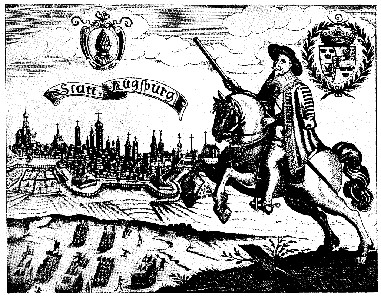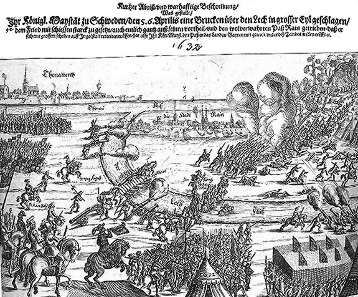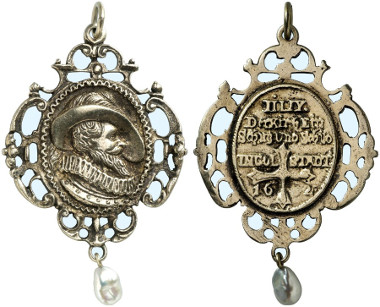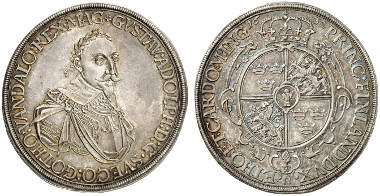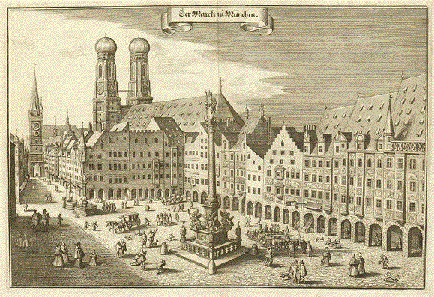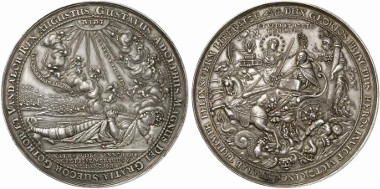translated by Annika Backe
Emperor Ferdinand II, who had been firmly convinced that he would have implemented his Edict of Restitution by force of arms as late as summer 1629, lost his allies one by one. His Spanish relatives could not bail him out, neither with money nor with soldiers, because the Habsburgs had lost their fleet as well as an army ready to fight in an attack by Dutch buccaneers in September 1631. At the same time, Gustavus Adolphus captured one important fortress at the Rhine River after another. In addition Richelieu successfully talked the prince electors of Cologne and Trier into submitting themselves to French protection. He even made the prince elector of Cologne deny Spanish troops passage through his territory. Thus, the Spanish Netherlands were completely cut off their supplies, and the capital city itself, Brussels, was in danger of being captured by the troops of the United Netherlands.
What else could Ferdinand do than to approach Wallenstein again, in that time of distress? Wallenstein put the emperor on hold for quite some time, and, after some hesitation, finally promised to have an army assembled by the end of March. Open questions for the time-being were who should pay for and who should be in command of that army.
Gustavus II Adolphus at the city walls of Augsburg, 1632. Source: Wikicommons.
On March 2, 1632, Gustavus Adolphus left his winter quarters. He intended to conquer the wealthy free imperial city of Augsburg. The only thing between him and Augsburg was Tilly with what remained of his army, accompanied by Maximilian of Bavaria who, in the hour of danger, wanted to be where decisions had to be made.
On April 7, Gustavus Adolphus crossed the Danube River near Donauwörth. While his soldiers had been supplied with everything they needed in an exemplary manner so far, in order not to alienate potential allies by violently pillaging, this time the military commander ordered the country to be systematically devastated instead so that no other army could replenish from that country again.
Contemporary depiction of the Battle of Rain 1632. Source: Wikicommons.
When Gustavus Adolphus marched in, the army of Wallenstein stood at the frontier of Bohemia, well-equipped and ready for action. It could have come to the rescue of Maximilian any time had Wallenstein not refused to do just that. Tilly’s insignificant troops, therefore, were not able to prevent the Swedes from crossing the Lech River on April 14, 1632. During that skirmish, Tilly was seriously injured.
Gnadenpfennig bearing the portrait of Count of Tilly on his death in 1632. Auction sale Grün Heidelberg 63 (2014), 1011.
He died in Ingolstadt as a result of his wounds. His last word is said to have been “Regensburg”, the name of the free imperial city that secured the liaison between the two imperial armies that stood in Bavaria and in Bohemia.
Germany. Augsburg. Under Gustavus II Adolphus. Reichsthaler, 1632. Auction sale Künker 254 (2014), 3067.
After the death of Tilly Maximilian assumed command. He could not prevent Gustavus Adolphus from invading Augsburg on April 24, 1632, though. As war contribution, the Swedes demanded 30,000 thaler per month from the citizens of that rich city that was outright destitute by the time the war was over.
Matthäus Merian, Marienplatz (Mary’s Square) in Munich, 1642. Source: Wikicommons.
Maximilian of Bavaria had decided to prioritize Regensburg. He deemed it more important to hold the city at the Danube and hence secure the way for the troops of Wallenstein than to defend his own capital city. Wallenstein thus captured Munich in the middle of May. It took the citizens of Munich 250,000 thaler to avert the Swedish pillages.
Shortly before, Wallenstein had finally decided to answer the plea of Emperor Ferdinand II and to lead his troops into battle again. Before coming to Maximilian’s rescue, however, he wanted to retake the Habsburg territories in Bohemia first.
He sent the Saxons the signal that he intended to intervene militarily to the effect that John George ordered his troops to retreat as quickly as possible and without sustaining casualties. Just like many other German princes, the Saxon prince elector, too, was not pleased with his ally. He condemned Gustavus Adolphus transferring German territories to Swedish marshals and speculating in public that he, the Swedish king, stood a good chance of becoming the first Holy Roman Emperor adhering to the Protestant faith. Hence, John George was not willing anymore to contribute with his own forces to the Swedes gaining more and more power in Germany. He withdrew his troops from Prague and, on May 25, 1632, Wallenstein occupied the city.
Strictly speaking, the time had come for Wallenstein to come to Maximilian’s aid whose territories were still threatened by Swedish troops. Yet Wallenstein preferred to go after the part of the Swedish army, led by Gustavus Adolphus, which had retreated to the city of Nuremberg in the meantime and then headed for Saxony to make defected Prince Elector John George see reason. On November 16, 1632, Wallenstein caught up with Gustavus Adolphus.
Sweden. Gustavus II Adolphus. Silver medal 1634 by S. Dadler on the death of King Gustavus II Adolphus. Auction sale Künker 194 (2011), 2617.
Leipzig was almost within reach. 24 kilometers west of the city, the Swedish king confronted the army of Wallenstein that was being entrenched near Lützen. The Swedes obtained a great victory, achieved by Bernhard of Saxe-Weimar. Gustavus Adolphus was killed in that battle. He was found later, his body stripped, exhibiting several bullet and stab wounds.
In the next episode you are going to read how Wallenstein died.
All parts of the series can be found here.




